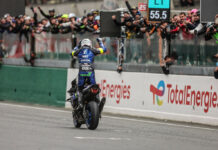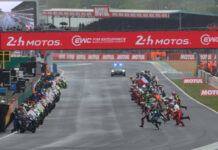From a press release issued by Team Suzuki:
UP-BEAT TEAM SUZUKI HEAD FOR THE FIESTA
Spanish GP Preview. Round 2, Jerez de la Frontera, Spain, May 2, 2004
After a highly encouraging start to the season in South Africa, Team Suzuki MotoGP riders Kenny Roberts Jr. and John Hopkins head back to Jerez with high hopes, their pre-season optimism reinforced.
The same goes for the whole team, as they prepare for the second race of the season, the Spanish GP. The GP at the now classic Andalucian circuit also marks the start of the European season – a dogged week-in week-out campaign that tests the strengths of riders and teams to the limit.
The Moto-GP crazy Spanish fans can be relied on for a memorable opening round. Vast crowds flock to the picturesque capital of the sherry-producing district, and the GP is a fiesta all of its own, in a region where they take the task of celebrating very seriously. On race day, the natural grandstands around the 2.748 mile / 4.423 km track will be packed with 130,000 fans, clamouring to see their heroes in typically close MotoGP action.
The Africa’s GP at Welkom opened the eagerly-awaited 2004 MotoGP season, and clearly proved the prowess of the latest version of the 220-plus horsepower Suzuki GSV-R MotoGP prototype. Roberts put up a strong performance to qualify tenth, with team-mate Hopkins joining him on the fourth row of the new three-by-three starting grid. An electronic glitch brought Kenny’s race to a premature end while he was well-placed in the top ten, and sizing up the opposition. Hopkins lost ground in some hectic tangles on the first lap, but finished 13th and in the points, highly confident of better things to come.
Jerez is the first of three GPs in bike-mad Spain, and this is the riders’ second visit so far this season. Team Suzuki and almost all their MotoGP rivals took part in IRTA tests at the start of April, two weeks before the season began. Kenny Roberts set second-fastest time, only one hundredth of a second slower than South African GP winner Valentino Rossi, with Hopkins close behind, and sixth overall. Results that mean the revitalised Suzuki team is looking forward to the forthcoming race with relish.
The upturn in the long-established and much-decorated factory team’s fortunes has come after two years race-developing radical new designs and solutions in the 990cc V4 GSV-R MotoGP machine. Relatively minor changes to Suzuki’s most powerful ever racing machine, along with a switch to Bridgestone tyres, have unleashed the competitive edge that was always within the motorcycle. Better still, there is more on the way – including engine revisions in the pipeline.
“Right now, the factory is testing parts aimed at answering the rider’s requests for more horsepower,” said team manager Garry Taylor.
“In fact, both these things are as usual – development at the factory is always continuous; and I have yet to meet a top-level rider who doesn’t always want more horsepower.
“The difference now is that we have been seeing very positive results from the latest developments and every sign that we can continue going in the right direction,” he said.
The Jerez race is followed by two days of testing … Suzuki expect to join several other teams at the circuit, where they will further perfect the latest engine and chassis developments and work with Bridgestone tyre technicians to gather further data.
“The whole start to the season has been so encouraging and uplifting for the whole team,” said Taylor. “We know that there is a long way to go, but everybody can see how much progress we’ve already made.
“There’s an air of optimism in the pit and everybody is confident that we can keep closing in on our ultimate target, of fighting again for race wins, and the championship we last won in 2000.” he said.
The Spanish GP is followed in quick succession by the French and Italian races as the European season follows on to its conclusion in September – interrupted only by a quick trip to Rio de Janeiro and a brief summer break. There are 16 rounds in the 2004 MotoGP World Championship.
KENNY ROBERTS Jr. – EVERYTHING FROM HERE LOOKS UP:
“I think our team could be pretty happy with the way the last race weekend went, on a grand scale. Sometimes you don’t get a finish, and it was one of those days. But we’ve shown that Suzuki can get to a better position. I think South Africa was the worst-prepared we’ll be all year – from here on everything just looks up. We have some exciting stuff coming for Jerez, if not for the race, for testing on Monday. I’m really looking forward to the weekend.”
JOHN HOPKINS – HIGH HOPES, THAT’S FOR SURE:
Jerez has always been a really good track for me. I got my best result of the season there last year. I really like it. Then at the last tests, we found a race tyre there from the Bridgestones that was really excellent – it just connected with our bike and that track. I’m going to be training my ass off and going there with high hopes, that’s for sure.”
ABOUT THIS RACE:
Jerez celebrates its 18th year as a GP venue, but only its 17th as host to the Spanish GP. The exception was in 1988 when it replaced the cancelled Portuguese GP with the Expo 92 event. By then, the Andalucian venue was already well-established as an important start to the European season, attracting huge crowds to the venue outside the capital of Spain’s sherry district between Cadiz and Seville. The crowds kept on growing over the years, as did the race’s importance in line with Spain’s growing love affair with GP racing. Now it is the first of four events on the Iberian peninsula, where motorcycle GP racing is second in popularity only to soccer. The Spanish GP also coincides with a number of springtime fairs in the region, making it an early holiday race for crowds, who can expect sunny if not necessarily always hot weather.”
ABOUT THIS TRACK:
The circuit at Jerez de la Frontera began a major upgrade two years ago with the track fully resurfaced, and pit and paddock buildings extensively rebuilt to bring the former showpiece of Spanish racing up to the standards of newer tracks at Barcelona and Valencia. The track, originally commissioned by the municipality of Jerez in the late Eighties, had a twisting lap making good use of the surrounding hillsides to provide natural grandstands and extensive views. The first layout was not universally popular with riders, but the track was lengthened slightly in 1992, replacing one slow section with faster curves. The result was exemplary, much improving the track with a minimum of disruption. Since that time the venue has grown in stature and popularity to become one of Europe’s premier motor sport events, drawing weekend crowds in excess of 200,000. With a lap of 2.748 miles (4.423km) and a lap record speed of 95mph (153km/h), Jerez is still a fairly slow circuit, but with enough faster corners to make it interesting. A quirk is extreme sensitivity to temperature, with grip levels changing morning to afternoon.
GP DATA
Jerez de la Frontera.
Circuit Length: 2.748 miles / 4.423 km).
Lap Record: 1:42.788 – 96.256 mph / 154.909 km/h. Valentino Rossi, 2003.
2003 Race Winner: V Rossi (Honda).
2003 Race Average: 46.50.345 – 95.055 mph / 152.976 km/h.
2003 Fastest Race Lap: see lap record.
2003 Pole Position: L Capirossi (Ducati) 1:41.983.
2003 KENNY ROBERTS (Suzuki) Race: 13th. Qualification: 17th – 1:43.026.
2003 JOHN HOPKINS Race: Seventh. Qualification: Seventh, 1:42.579.
Team Suzuki Optimistic Heading Into The Spanish GP At Jerez
Team Suzuki Optimistic Heading Into The Spanish GP At Jerez
© 2004, Roadracing World Publishing, Inc.






